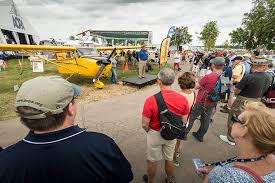Monthly Archives: September 2015
September 22, 2015
“The ideas and alternatives we consider need to conform to the legal and safety standards of the industry and they have to make sense from an economic point of view–otherwise they literally won’t fly. But we can’t ignore the needs and requirements of the entry level prospects in general aviation or we’ll simply price ourselves out of existence.” –An EAA AirVenture attendee after looking at a remanufactured Ascend 172 in the AOPA exhibit
Learning to fly never seemed like a minor expense, even back in the mid-1970s when I learned to fly at one of the nation’s hundreds of Cessna Pilot Centers and a new Skyhawk II was available for less than $30,000, complete with an ARC Nav Pac. It still meant forking over $25 an hour for the airplane and $15 for the instructor and there were fees for the CPC kit, ground school, the Third Class medical, the radio operators license, the fuel–especially on the cross country flights, and the check ride. And don’t forget the $20 “wardrobe fee” after you got the shirttail cut off when you soloed on a day you didn’t expect to and wore your favorite Oxford. The more hours it took to master the “magic” of getting an airplane safely into the air and back down again, preferably at your intended destination, the more the investment. It could end up costing thousands of dollars. That was back then. Nowadays, that’s what it costs just to solo–not including the shirt!
The $30,000, which was the retail price for the airplane in 1975, is now closer to the purchase price for the flight training. Add about $400,000 to that tab if you want a new Skyhawk. Oh, you’ll get a radio package that’s a little more sophisticated than the ARC Nav Pac, a Garmin 1000 glass panel, in fact, but you’ll still get four seats, the same basic payload, and roughly the same climb, cruise, speed, and range performance and the instructor will cost about four or five times as much, but the actual experience and requirements aren’t going to be that much different–are they? Well, maybe due to video games, the availability of extraordinarily realistic simulation and computerized graphics, and the fact that kids have become familiar with joysticks and touch screens from the time they’re able to count or speak in sentences, it may not be quite as exhilarating to actually control an airplane, but traveling from place to place in half the time it takes to drive should still offer some attraction.
But, the real question isn’t whether flying or learning to fly is enough to attract potential pilots, it’s whether the cost to acquire an airplane or flight training is so high that it will eventually–and perhaps rapidly–result in the end of pilot education as we’ve known it. The private pilot will become a part of history. General Aviation flying will be virtually non-existent, or about as common as that of classic warbirds and collectible aircraft–making appearances at rare, weekend fly-ins where the curious can come out, pay a fee to see the privately-owned, owner-flown airplanes of the past when real human beings actually got behind the controls and controlled the aircraft themselves–and could afford to do so.
Today’s airframe manufacturers really seem to think that several hundred thousand dollars is not too much to charge for a four-place airplane that will fly less than 1000 miles on a tank of gas at less than 200 miles per hour. The concept of taking the family on a day trip for the proverbial “$100 hamburger” is fast being relegated to the annals of history, too. The $100 hamburger is more like a $800 Quinoa and Tofu burger.
The alternative is to offer ways to acquire and update existing airplanes–there are still tens of thousands of flyable Cessnas, Pipers, Beechcraft, Cirrus, Mooneys, Meyers, Bellancas and others out there–that can be revitalized and utilized, even in the Next Generation air traffic control system, if the industry doesn’t shoot itself in the foot trying to regulate and price itself out of existence. There are some great companies out there that have the legacy airplane owners in mind. Yingling Aviation is one: they’ve announced a “remanufactured 172” that is an exceptional value and brings 30 year old airframes up to nearly new specs and performance, complete with glass cockpits if desired, at about a third the cost of a new airplane. TKM in Phoenix offers “plug and play” replacement avionics for legacy models and they’ll work with and allow older airplanes to operate in the Next Gen environment. There are companies actively working on alternative fuels and engine technology to keep those airplanes flying if and when 100LL becomes 100 % unavailable, too. It’s really time to give these guys some attention and some support so they can give the dwindling, existing pilot population some encouragement and the prospective pilot population some hope that they’ll be able to afford to get a pilot’s license–one that won’t cost them the shirt off their back!
